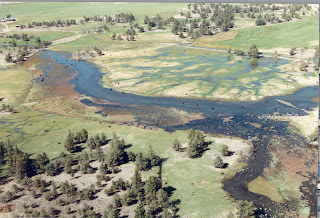
The bottled water issue is dwarfed by the magnitude of water quality and quantity issues worldwide —it is a symptom of much greater problems. But it does have the potential for significant localized impacts warranting discussion.
The December 12th congressional hearing illuminated the Food and Drug Administration (FDA) definition of spring water causes bottlers to pump in rural headwaters areas susceptible to impacts from groundwater pumping (there is a one-to-one ratio of groundwater pumping reducing stream flow). The hearing also showed that bottlers and citizens regularly dispute over scientific findings and that either legislation or enforcement is proving inadequate.
Siskiyou County Code Title 3 Chapter 13 Groundwater Management recognizes the need to protect basins from overdraft and excessive extraction for export, while exempting bottled water operations from needing a permit to export water from the county
(see http://municipalcodes.lexisnexis.com/codes/siskiyou/index.htm).
With four bottling plants in operation, Srivastava approved, Nestle in environmental review, and Crystal Geyser planning to expand to be the largest in the world (see http://www.shastabusinesspark.com/development.html), reexamining Siskiyou county’s groundwater management plan is prudent. Otherwise we’ll continue to proceed ignorant of localized or cumulative impacts.
When the plan was amended in September 2001 the consulting attorney suggested amending the bottling export exemption to be limited to a certain quantity, i.e. “…provided that the annual groundwater extraction by the bottling water enterprise does not exceed ___ acre-feet per year,” essentially placing a cap on export without a permit. The language was not incorporated. Thus the bottlers continue to export an unknown amount of water with unknown impacts.
The permitting process in the groundwater management plan is strong, and science based. If I knew that bottlers had collected baseline data and performed rigorous long-term monitoring I’d be at ease that my downstream well wouldn’t be impacted. But to my knowledge this is not the case, or the information isn’t public. Wouldn’t it make sense to require a permit so that the public interest in groundwater is protected?
A memo from Nestle attorneys in the county record on the Nestle project documented their exemption from the county groundwater plan because they intend to export spring water. Thus raised is the need to address the relationship between groundwater and surface water and how it is governed.
This year is the first time in Winnemem Wintu history that Panther Springs went dry. Horse Camp spring went dry. A well on the Nordic Center side of the Ski Park went dry. People are complaining their Christmas trees are dry. Why after only one dry year are we seeing precedent setting impacts that didn’t occur in past multiple dry years? Clearly springs and shallow groundwater are impacted in dry years.
The central tenant of climate change impacts on California’s water supply is uncertainty. Rigorous scientific inquiry including increased monitoring of our water is critical and the questions of governance are especially salient. How will we make decisions about water resource allocation in the face of uncertainty?
Nearly two years ago I wrote regarding the need for comprehensive watershed science to inform the development of a county water plan. We’ve come a long way; resultant from the Nestle/McCloud controversy Mount Shasta’s water resources are now on the National map. Congress understands the need to support United States Geological Survey to map and monitor groundwater resources.
Still, we can’t wait for science to amend the groundwater plan, nor to commence in the development of a county water plan as intended in Sec. 3-13.101 (h) of the groundwater management plan: “The County will undertake as resources permit to develop a County water plan to more specifically address water availability, needs and usages in an attempt to foster prudent water management practices to avoid significant adverse overdraft-related environmental, social and economic impacts”.
We have a remarkable distance yet to travel in our journey to protect our most precious resource, and I hope it will involve all of our county’s diverse interests.

